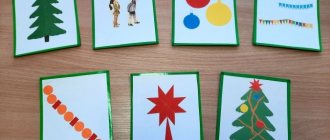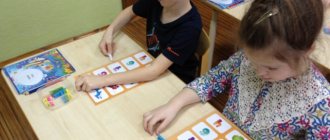Quest game “In search of the lost word”
author: Zvereva Larisa Aleksandrovna
teacher-speech therapist MBDOU DS No. 10 Technological map of GCD for preparation for teaching literacy in the preparatory group
Quest game “In search of the lost word”
Municipal budgetary preschool educational institution
kindergarten No. 10 “Rodnichok”
Technological map of GCD for preparation for training
literacy in the preparatory group
Quest game “In search of the lost word”
Prepared by: speech therapist teacher
Zvereva Larisa Alexandrovna
Ozersk, 2019
GCD type: Final lesson-game with elements of quest technology.
Form of organization: group.
Age group: preparatory. Educational areas: speech development, social and communicative development, cognitive development.
GOAL: consolidation of skills acquired in the process of educational development of speech and preparation for learning to read and write.
Tasks:
Educational:
Improve skills:
- select antonyms,
- make up words and sentences,
- find related words and select adjectives for them,
- recognize sounds in a word.
Developmental:
-develop communication skills;
-logical thinking, attention, intelligence;
-promote the development of fine motor skills of the hands as an effective means of overcoming speech disorders;
Educational:
- cultivate interest in working with words and sounds;
-the ability to listen to each other, tactfully complement the answers of comrades if necessary;
- skills of self-control, self-esteem and mutual assessment.
— improve the ability to work in a team, the desire to help each other; Additional tasks:
Game task
: consolidate the ability to play d/games using quest technology.
Planned results:
- children have an idea of the concepts of “sound” and “letter”;
- skillfully apply their knowledge;
- are able to actively interact with peers and adults, perform individual and collective tasks;
— have the skills to participate in gaming activities using quest technology.
Methodical techniques:
Verbal: conversation about vowels and consonants, questions, explanations.
Visual: pictures with tasks, diagrams
Gaming: didactic games
Practical: exercises in printed cards Materials and equipment: Necessary material: envelope with the task (sheet according to the color of the rainbow), objects arranged in a group corresponding to the description, ball, letter “A” (on a sheet), a set of letters for each child, corresponding pictures words.
GCD move:
Technological map of GCD
| № | GCD stages | Methods and techniques | GCD move | ||
| Activities of a teacher | Children's activities | Planned results | |||
| 1. Introductory part Motivational stage | Organizing time | -Guys, today I want to offer you a quest? what does this mean, do you know? What is a quest?) quest translated from English means search, and a quest game is an adventure game. In this game there are always tasks that must be completed in order to find or receive a message, and maybe a treasure. Well, shall we take the quest? | children's answers | Create a positive emotional mood | |
| Surprise moment | - Guys, what kind of envelope do you think this is? There is a letter and a map in it. what does it mean? the letter says: White field, Black seed, He who sows it, He understands, He who knows it, He will unravel. And this is your waybill. | children's answers | Build motivation in children to work Arouse interest in the activity with the help of a game situation and a surprise moment | ||
| GCD goal setting | And so, in front of you is an encrypted word, in order to decipher it you need to complete 7 tasks. Having completed the task, you receive a letter (the teacher shows a sheet painted with all the colors of the rainbow). Who will be responsible for storing the letters? | Children choose a team captain who will be responsible for the letter cards | The goal of the lesson was set by the children. | ||
| 2. Main part Content stage | Task No. 1 | The first color is red. The children are given the task of finding a red object in the group, made of fabric, with colored polka dots (curtain). Under this object there is a note with the task. Game "On the contrary" After answering, children receive the first letter “G” | children's answers | Ability to name words with antonyms. Children are able to name words that have opposite meanings and consolidate knowledge about their surroundings. | |
| Task No. 2 | Second color – orange The children are given the task to find in the group an orange object, small in size, round in shape, made of plastic (orange), under this object there is a note with the task. Game "Make a word" children use cards with letters to form this word (book) on the tables For children who have difficulty or do not know the letter, the teacher shows the spelling of this word. Having coped, the children receive the next letter “R” | Children, using cards with letters, make up this word on the tables, help each other, and analyze the word that came out. | The prerequisites for learning to read and write have been created An optical image of a letter and the ability to find it among other letters have been formed. Developed skills of mutual assistance and self-control | ||
| Task No. 3 | The third color is yellow The children are given the task to find in the group a yellow, large object, a headdress, needed by people in dangerous professions (helmet). Under this item is a note with a task. Game "Related Words" Having coped, the children receive the next letter “A” | Children form new words from a given word | The ability to form new words from a given word has been developed. | ||
| Task No. 4 | The fourth color is green The children are given the task of finding a green, large object made of glass (vase) in the group. Below this item is a task. Game “Make a sentence from words.” Having coped, the children receive the next letter “M” | Team 1: children make a sentence out of words Team 2: children who cannot read lay out a sentence from pictures and diagrams. | The ability to switch from one type of activity to another has been developed. Spatial orientation and the ability to construct words into sentences have been developed | ||
| Task No. 5 | The fifth color is blue. The children are given the task of finding a medium-sized object in the group, made of rubber, with blue fabric on top. Below this item is a task. Game “Names with sound A” (children need to line up in one column whose name contains the sound A. If the child’s name does not have this sound, you need to call him affectionately. For example: Ilya - Ilyushenka). Then all the children will line up in one column. Having coped, the children receive the next letter “A” | Children pronounce each other’s names out loud and determine the presence of the sound “A” | The ability to work in groups has been developed. The ability to identify repeating sounds in all words has been developed. | ||
| Task No. 6 | Sixth color - blue The children are given the task to find in the group a round-shaped object, small in size, made of polystyrene foam in a blue suit with gold snowflakes, under this object there is a task. Game "My, mine, mine" Children are shown pictures and they choose a pronoun. Once completed, children receive the next letter “T” | Children arrange cards according to tables with pronouns | The ability to coordinate a noun with a pronoun in gender and number has been developed | ||
| Task No. 7 | The seventh color is purple Children are given the task of finding a purple, large, hemispherical object with massage fingers. Below this item is a task. Game "Catch the syllable". The teacher names a syllable, and the children must come up with a word starting with this syllable (for example: vo-voda, se-secret, zi-zima, etc.). Having coped, the children receive the next letter “O” | Children name words starting with a given syllable | The ability to divide words into syllables has been developed | ||
| 3. Final part 1) Reflective 2) Motivation for subsequent work | After all the tasks, the teacher lays out the word LITERATURE on the board and asks about the meaning of this word. — Guardian of letters, show us the cards. Let's try to collect the word that was in the riddle? Teacher: Literacy is the ability to write and read. All our tasks today will help you become literate students at school in the future. There is a saying: Learning to read and write is always useful. reflection | children's answers | The ability to give complete, accurate answers to the teacher’s questions has been developed. Generated interest in further work | ||
March
15
2018
Municipal budgetary preschool educational institution
"Combined kindergarten No. 5"
“Application of innovative quest technology in speech therapy work with children with disabilities”
(demonstration of a video fragment of an integrated lesson with preschoolers)
Prepared by: Sidorenko I. V.,
teacher speech therapist
I qualification category
Presentation()
(Slide No. 1)
Dear colleagues! The topic of my speech: “ Quest technology in working with preschoolers”
(Slide No. 2)
In the process of modernizing the preschool education system, new conditions for the upbringing and education of children, including children with special educational needs, are emerging today.
In the pedagogical process, innovations act as new implementations in the organization of interaction between teacher and child. Every year, innovative forms of work expand the capabilities of teachers, including speech therapists, in working with preschoolers with special needs development disorders.
It is no secret that preschoolers with ODD have a low level of vocabulary development, use of speech structures, poor speech, low level of motivation and communicative development. In order to develop interest, motivate and create conditions for in-depth development of speech and the formation of new knowledge, speech therapy assistance can be provided in the context of a game. One of these modern game formats that is positively perceived by young people is the quest.
(Sly #3)
First you should find out what the word “quest” actually means. It is translated from English as “search”. In a general sense, this concept denotes any plot that involves achieving a goal by overcoming any obstacles.
The ancestors of “real” quests are computer games. The first attempt to transfer a virtual quest into reality was made in Asian countries in 2007, and in Russia in 2013. As you can see, this is a fairly new and young innovation that is confidently and widely gaining momentum, including in education.
(Slide No. 4)
An educational quest is a completely new form of educational and entertainment programs, with the help of which children are completely immersed in what is happening, receive a charge of positive emotions and are actively involved in activities.
(Slide No. 5)
In order to effectively organize children's quests, you should adhere to certain principles.
1. Navigation principle. The teacher acts as a coordinator of the educational process , guides the children, “pushes” them to the right decision, but the children make the final conclusions on their own. The teacher’s task is to motivate the child to independently search for information.
2. The principle of accessibility of tasks. The tasks correspond to the age and individual characteristics of preschoolers.
3. Systematic principle. The tasks are logically related to each other.
4. The principle of emotional coloring of tasks. Methodological and educational tasks are hidden behind game techniques.
5. The principle of integration. Using different types of children's activities and integrating educational areas when conducting quests .
6. The principle of reasonableness in time. Quests in preschool age can be short-term, or they can be long-term in nature, when it takes several days to complete the tasks.
7. The principle of voluntariness of the child’s educational actions . The teacher needs to structure the educational process a way as to motivate the child so much and to such an extent that it will allow him to fulfill our requests (tasks) voluntarily, without coercion and authoritarianism. Mandatory requests do occur, but to a minimum extent.
8. The principle of the presence of choice. Sometimes it is very important for a teacher that a child does something, then he needs to present it in such a way that the child perceives the task as the result of his own desire, he needs to be given a huge choice of means.
We present to your attention a fragment of a video of an integrated speech therapy lesson in the form of a quest.
The lesson was conducted with children from the compensatory group with special needs, aged 5-6 years.
(Slide number 6 ) Watch the video
(Slide No. 7)
Algorithm for conducting and organizing quest games.
1.Defining a theme
Quest topics can be very different:
- Treasure Hunt
- Help heroes or hero
- Cognitive
- With a variety of experiences and experiments
- Literary quests
- Physical education holidays.
2. The organizer sets himself the goals and objectives, taking into account the category of participants (children, parents)
3. Determine the location of the game
4. Make a route map or a passport for completing the stages
To create a route, you can use different options:
- Route sheet (the stations can simply be written on it sequentially and where they are located; or there can be riddles, rebuses, an encrypted word, the answer to which will be the place where you need to go);
- “Magic ball” (notes are sequentially attached to a ball of thread with the name of the place where they need to go. Gradually unwinding the ball, children move from station to station);
- Map (schematic representation of the route);
- “Magic screen” (tablet or laptop, where photographs of the places where participants should go are sequentially located)
5. Form the composition of participants (teachers, children, specialists, parents, number of organizers and assistants
In kindergarten, quests can be carried out in different age groups, starting with the youngest. But most often in older groups, where children already have skills and a certain amount of knowledge and abilities. Not only children, but also parents take part in many quests.
6. Develop a legend of the game, its format and rules, write a script, (summary) The script should be clear, detailed, thought out to the smallest detail.
7. Prepare tasks and props for the game
Tasks for a children's quest can be very diverse: riddles; puzzles; games “Find the differences”, “What’s extra?”; puzzles; creative tasks; sand games; with water; experiments, experiments; labyrinths; sports relay races.
8. Discuss the date and motivate the participants
9. Conducting the game
10. Summarizing and presenting the results of the game (story, collage, newspaper, information sheet, etc.)
11. Analyze the results obtained (weaknesses, strengths, opportunities and threats)
(Slide No. 8)
Quests have a large number of advantages for preschool children, which in many areas fully comply with the Federal State Educational Standard for Education: quests naturally integrate educational areas, combine different types of children's activities and forms of work with children. Quests allow you to unite all participants in the educational process (children, parents of students and teachers) in solving educational problems in a playful and entertaining form.
(Slide No. 9)
A kindergarten today should be in a development mode, not a functioning mode, and should be a mobile system. Depending on this, the forms and directions of the kindergarten’s work should change. First of all, new forms and methods of work should be actively used. One of these forms is the organization and conduct of quests, which allow you to expand the scope of the educational space.
Thank you for your attention!




